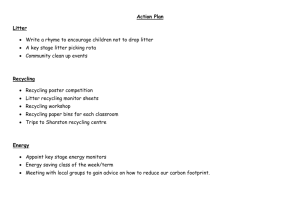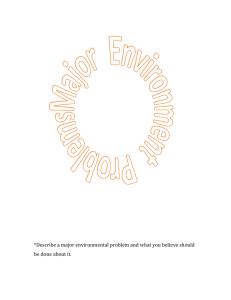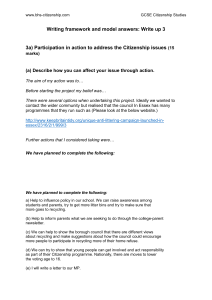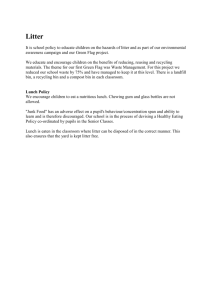Clean Valley Council, Inc. Linda Barker
advertisement
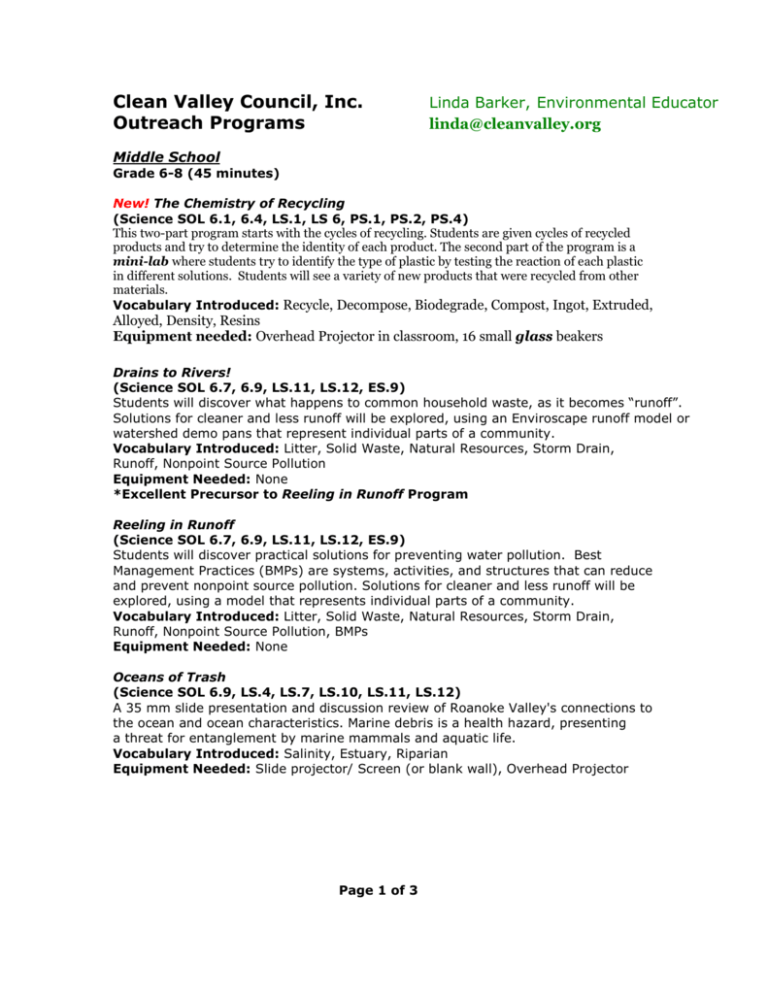
Clean Valley Council, Inc. Outreach Programs Linda Barker, Environmental Educator linda@cleanvalley.org Middle School Grade 6-8 (45 minutes) New! The Chemistry of Recycling (Science SOL 6.1, 6.4, LS.1, LS 6, PS.1, PS.2, PS.4) This two-part program starts with the cycles of recycling. Students are given cycles of recycled products and try to determine the identity of each product. The second part of the program is a mini-lab where students try to identify the type of plastic by testing the reaction of each plastic in different solutions. Students will see a variety of new products that were recycled from other materials. Vocabulary Introduced: Recycle, Decompose, Biodegrade, Compost, Ingot, Extruded, Alloyed, Density, Resins Equipment needed: Overhead Projector in classroom, 16 small glass beakers Drains to Rivers! (Science SOL 6.7, 6.9, LS.11, LS.12, ES.9) Students will discover what happens to common household waste, as it becomes “runoff”. Solutions for cleaner and less runoff will be explored, using an Enviroscape runoff model or watershed demo pans that represent individual parts of a community. Vocabulary Introduced: Litter, Solid Waste, Natural Resources, Storm Drain, Runoff, Nonpoint Source Pollution Equipment Needed: None *Excellent Precursor to Reeling in Runoff Program Reeling in Runoff (Science SOL 6.7, 6.9, LS.11, LS.12, ES.9) Students will discover practical solutions for preventing water pollution. Best Management Practices (BMPs) are systems, activities, and structures that can reduce and prevent nonpoint source pollution. Solutions for cleaner and less runoff will be explored, using a model that represents individual parts of a community. Vocabulary Introduced: Litter, Solid Waste, Natural Resources, Storm Drain, Runoff, Nonpoint Source Pollution, BMPs Equipment Needed: None Oceans of Trash (Science SOL 6.9, LS.4, LS.7, LS.10, LS.11, LS.12) A 35 mm slide presentation and discussion review of Roanoke Valley's connections to the ocean and ocean characteristics. Marine debris is a health hazard, presenting a threat for entanglement by marine mammals and aquatic life. Vocabulary Introduced: Salinity, Estuary, Riparian Equipment Needed: Slide projector/ Screen (or blank wall), Overhead Projector Page 1 of 3 Environmental Jeopardy New! Water Jeopardy (Science SOL 6.2, 6.3, 6.6, 6.9, LS.7, LS.12, PS.6) Students will examine aspects of environmental issues, and then play a fun interactive game reviewing what they have learned. Four topics to choose from (choose one) are Energy, Solid Waste, Ecological Footprint, or Water. Vocabulary Introduced: Energy, Natural Resources, Renewable Resources, Litter, Solid Waste, Recycle Equipment needed: None Stream School (offered in the Fall and Spring) Science SOL 6.5, 6.7, LS.7, LS.10, LS.12, ES.7, ES.9, ES.11, BIO.3, BIO.9, CH.1) Students will participate in a field trip experience at a local stream to identify macroinvertebrates and perform chemical tests. This will enhance their understanding of the factors involved in determining water quality, and the connection between point source and non-point source pollution in their waterways. Vocabulary Introduced: Riparian Corridor, Litter, Erosion, Point Source Pollution, Nonpoint Source Pollution Equipment Needed: Old sneakers or water shoes/boots Watershed Connections (Science SOL 6.3, 6.5, 6.7, 6.9, LS.7, LS.10, LS.12) A 35 mm slide presentation and discussion will examine watersheds and determine the problems associated with erosion, pollution, and litter. Vocabulary Introduced: Riparian Corridor, Litter, Erosion Equipment needed: Screen, Electrical Outlet Plants Eat Bad Chemicals (Science SOL 6.7, 6.9, LS.3, LS.4, LS.7, LS.10, PS.7) The students will learn about the process of Phytoremediation, where plants remove, transfer, stabilize or destroy contaminants in soil and groundwater. Through classroom demonstrations the students will observe groundwater and soil contamination as a result of chemicals accumulating in soil and water, and review plant anatomy. Vocabulary Introduced: Phytoremediation, Groundwater, Transpiration, Contamination, Infiltration, Riparian Equipment Needed: None Water: Nature’s Recycling System: (Science SOL 6.1, 6.7, 6.9, LS.1, LS.3, LS.7, LS.10) This interactive program takes students through the Water Cycle with emphasis on water management, topography, infiltration, runoff and erosion. Through hands on activities and demonstrations students will discuss these occurrences and how they are influenced by human activities. Vocabulary Introduced: Precipitation, Evaporation, Transpiration, Topography, Infiltration, Erosion, Runoff Equipment Needed: None Page 2 of 3 Land Use: For the People, the Government, or the Environment?: (Science SOL:6.2, 6.5, LS.12) Students will discover what decisions need to be made when they try to place a school on a tract of land that has many aspects to be considered: citizens, government regulations, environmental impacts. These decisions will carry costs and benefits, value, and personal choices. Principles to be discussed include: a. scarcity forces choices b. resource management decisions are made by people acting alone or in groups c. changes in rules and laws alter incentives and decisions d. people value things differently. Vocabulary Introduced: Costs and Benefits = positive and negative factors involved as a result of choices Natural Resources = all the Earth’s materials that make other products Incentives = rewards or punishment for behavior Hammock = stand of preserved, original trees Hazardous Waste = waste that is harmful to the environment and people Groundwater = water found beneath the soil’s surface Water conservation = the careful use and protection of water resources in quantity and quality Wetlands = landforms that are wet at least part of the year and have a particular type of soil and plants Scrub Habitat = area with small trees, bushes or plants that have low moisture Superfund = underground storage site of hazardous waste on a list to be cleaned up and restored by the government Watershed address = area you live in that drains to the nearest creek, stream, or river Equipment needed: Overhead projector Aluminum (Plastic, or Paper) Recycling (Science SOL 6.2, 6.6, 6.9, LS.12) Students will follow a can to a recycling center and learn about recycling, how it works, why it’s important, what they can do to help. Trash can be dangerous when it’s not in its proper place: the garbage can or recycling can. Students will keep one piece of litter (aluminum can) in mind as they follow it from the street to a new container or usable item. This program can also substitute “Paper Recycling” or “Plastic Recycling” for the title. Students will see a variety of new materials that were recycled from other materials. Vocabulary Introduced: Recycling, Reduce, Reuse, Natural Resources, Machines Equipment needed: VCR Page 3 of 3


